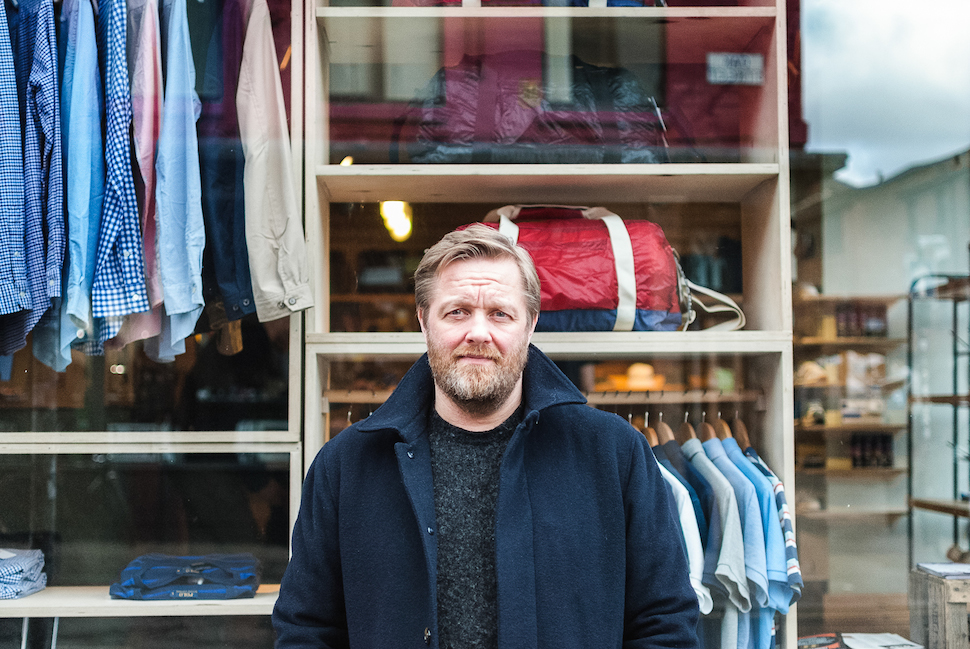Steve Sanderson and Nigel Lawson are co-owners of probably one of the most quintessentially unique clothing stores in Britain – Oi Polloi. Over the past 15 years the pair have gone from running a small self-funded startup, to having 30 employees across multiple cities.
The pair sell premium garments, sourced from across the globe, and co owner Steve’s evident eye for beauty has meant that all too often, Oi Polloi have set the trends for others to follow. In this special episode of The Professionals, I catch up with Steve to discuss the ins and outs of running a clothing store.
“You need to be prepared to do everything for nothing whilst your getting started. If you can stomach that, reinvest the money, buy well, and find the customers as well as sell to them, then you will make a profit. Then you need staff.”
Pete Malla: HOW DID YOU GET INTO OWNING A SHOP?
Steve Sanderson: A very rough outline of what happened for us was – me and Nigel had a conversation to start a shop, and so we both put a small amount of money in, maybe £16K between us. We then found a small unit in the city centre of Manchester back in 2002 and opened. In the beginning I cut hair in the basement to bring people through the door as automatic footfall. I’d been doing this for a few years so already had some customers to bring in. The money coming in from me hairdressing covered the bills at the time.
So I was cutting hair and then we had the idea of – why don’t we have a website. Someone I was cutting hair for was a web developer. I had friends who were photographers, so they could help us with displaying the products, and taught us how to use the cameras. And it was all done hand to mouth.
At this point we earn’t nothing, probably £40 a week for a couple of years. Thats the initial bit. And you need to be prepared to do everything for nothing whilst your getting started. If you can stomach that, reinvest the money, buy well, and find the customers as well as sell to them, then you will make a profit. So the next thing we needed to do was find some stuff to sell, and so we went on a tour across Europe to meet clothing companies and start buying vintage sportswear.

AND HOW WAS IT WHEN YOU FIRST APPROACHED BRANDS TO BUY?
We had no experience. We just explained that we had an idea. We wanted to sell vintage sportswear and functional outdoor gear, like Swedish label Fjallraven. In 2002 not many people new the brand, it was totally under the radar – (even way back in the eighties this was a rare terrace label picked up by a handful of lads).
We hired a car and did a European tour of trade shoes. We found a few nice bits of vintage sportswear and footwear, and the Danish comfort shoe Jacoform. We liked to search and find stuff. It made things interesting. We headed to Fjallraven headquarters, ran through our plans, they liked our idea. This is where it started.
WAS IT HARD IN THE BEGINNING TO TAKE ON BIGGER BRANDS. LOOK AT PEOPLE LIKE NORSE PROJECTS FOR EXAMPLE.
Norse approached us, we were one of the first places stocking them (in the UK). Another label was Belstaff. We picked them up quite early. We met their agent, and at the time they were selling their jackets to motorcycle shops. Their agent was a great guy. If it wasn’t for him, we probably wouldn’t have got it. I think getting Belstaff, so early on, really helped us establish the company and pull in higher level contemporary labels. They were such a respected label.
BUT YOU KNOW IT SEEMS LIKE AROUND THIS TIME IT WAS QUITE HARD TO SOURCE THESE UNIQUE OUTDOOR LINES. LET’S LOOK AT BARBOUR FOR EXAMPLE, WHO AT THE TIME WEREN’T REALLY PROMOTING THEIR FLY FISHING JACKETS TO YOUTH AUDIENCES…
Were they fuck. What we were doing at the time, was looking to find classic menswear items, putting together our own take on a slightly obsessive men’s wardrobe. We were buying golfing knitwear from Lyle & Scott (from a guy that only sold to golf shops and golf clubs). We were buying Barbour waxed jackets and fly fishing coats from people that were used to dealing with equestrian and outdoor pursuits people. We were looking outside the box of the traditional contemporary menswear. We wanted to put all these things together in one shop and repurpose everything so it could be worn in our world, by us & people like us.
YOU’VE HIGHLIGHTED EXAMPLES HERE WHERE YOUR MERCHANDISING IS AHEAD OF THE CUSP. WHAT IS IT YOU’RE LOOKING FOR WHEN BUYING?
Look to find things other people don’t have. Usually the stuff we want, isn’t readily available. Nothing we do is new. Everything’s been done before. We’re not trying to redo things, as before. We want to move it on. It’s about re-appropriation. Taking influences from the past; music, films, counterculture, regular culture, and then putting them back together, for now. Things are never quite the same the second time, third time or how ever many times you regurgitate stuff. It’s always different. Always new.
SO THAT WOULD THEN MEAN LOOKING FOR THE SUPPLIERS THAT ARE DOING WHAT IN YOUR MIND YOU IMAGINE.
Yeah but usually what happens with that is you have this idea, and this vision of what you want. But when you look for it it isn’t there. It seems like a simple and obvious thing, but usually the thing you’re chasing, doesn’t exist. Or you might find it and go, ‘wow’, that looks nothing like I remember, and the shapes are all off kilter.
“Well I think this is the mistake a lot of people make, is not taking people on.”
SO ON THAT NOTE THEN, WOULD YOU CONSIDER RUNNING YOUR OWN LINES?
Yeah I’m kind of exploring that at the moment. Why keep trying to find these things off other people when you could just make it yourself.
SO SLIGHTLY CHANGING THE TOPIC HERE, BUT LETS LOOK AT THE ROLE OF RUNNING A SHOP. FROM THE OUTSIDE IT LOOKS GLAMOUROUS AND EXCITING. BUT DOING IT AS A DAILY GRIND I’M SURE THAT CHANGES YOUR OUTLOOK. SO WHAT THINGS GET ON YOUR NERVES ABOUT RUNNING A STORE?
Well we started with two people and we now employ 30 for Oi Polloi. These are broken down into different teams. And I’m not into big things. I can’t handle them and it’s not how my head works. I prefer the content and buying processes. But when you’re running a business and get to a certain size, you have a responsibility to everybody. And at this size, you need to make certain commercial decisions, that are more for the business and not personal.
WHAT WAS THE POINT WHERE YOU THOUGHT, WE NEED TO TAKE ON OUR FIRST EMPLOYEE.
Well I think this is the mistake a lot of people make, is not taking people on. I think so many small operations start with a small team and end trying to do everything themselves.
Once sales began to ramp up on-line, it was becoming more difficult to find time to cut hair, and that’s when I went full time on the internet. So you have to make decisions to stop doing your comfort roles. And you have to look at what will be best for the business. Then once it starts getting too much to handle, you need to get someone else in to help. This bit is pretty tricky. You know you can’t afford them, but you want to grow the business…like I said, it’s tricky!
YEAH I CAN SEE HOW THAT MUST BE HARD, HAVING TO TAKE THESE RISKS OF SAYING ‘RIGHT WE NEED THIS PERSON BUT WE CAN’T AFFORD THEM, BUT THEIR OUTPUT WILL INCREASE BUSINESS GROWTH’.
Yeah, the thing is if you’re doing it right, the business keeps growing, next thing you know, it’s time to move into a bigger space, then into new premises, maybe another new website, more people…you get the picture?
THAT’S INTERESTING BECAUSE OI POLLOI KEEPS GROWING, AND SO DOES YOUR RESPONSIBILITIES, BUT I’D IMAGINE THAT AS OPERATIONS SCALE UP SO DOES YOUR MARGINS?
Well not strictly true, especially while you’re growing , when you’re taking on more shops and bigger buildings, more people. We’re not really that big and have never wanted to be the biggest shop in the world, maybe be one of the best. We’re reinvesting to grow the business and trying to improve every season. If you gave me a blank piece of paper, there would be things we’d do differently if we started over again.
AND WHAT WOULD THOSE THINGS BE?
Ummm……Selling our own products, with a better margin. Problem is once you’ve set something rolling in a certain way, it’s harder to engineer it to act differently. So if you start from scratch and say we’re doing it this way, it makes it easier.
“I would build an audience first, and then give them product.”
AND WHEREAS YOU STARTED FROM A BRICKS AND MORTAR, THEN MOVING INTO ONLINE, IF YOU COULD DO IT AGAIN WOULD YOU REVERSE THAT MODEL?
Yes. I would build an audience first, and then give them product. Go the opposite way. Most people make a product, and then try to find someone to buy it. So they spend all their time, designing and making this product. They come to us. Ask us if we’d like to sell it – “How much is it? How much?”. It’s not gonna sell. It’s too expensive. And from day 1, they’ve fucked up.
Lets say they’ve got £10,000. They’ve got no experience. First thing they’ve done is paid someone to build them a website that costs an extortionate amount. Pulled their pants down and gone here you go. Next thing they do is spend loads of money getting perfect samples, with all this special customisation that they think everyone is going to buy. But no one is going to buy it because no one’s every heard of them. Who are you? What do you stand for?
I hate seeing these people waste a load of money, and it’s a shame that people do this and get ripped off at every turn along the way. I see loads of really good ideas, but they’ve been managed poorly and they’ve blown their money before they’ve even started.
SO YOU TAKE THE ORGANIC GROWTH APPROACH.
Yeah, but just make sure there is an audience that wants it. Don’t come along and make a copycat of every other brand, because you won’t stand out.
AND BEING TRUTHFULLY HONEST, WHAT INFORMS YOUR BUYING THE MOST. IS IT THE BRAND, THE GARMENT, AUDIENCE, MOVEMENT?
Because I’ve been doing it for a while, now I’m looking for things ‘that will do a job’. We know the sort of products we and our customers like. So if we think we’re missing something we try to fill that gap . But, this is a fairly big BUT… I need to like the product, brand, and their story. There’s a few boxes that need to be ticked. They’re needs to be a good reason for them to be included.
Stone Island is good example. No idea what they stand for, joking, they’re about research and experimentation (apparently). They also make great jackets from interesting technical fabrics. Along the way they’ve made stuff that’s amazing, and other stuff that breaks. They’re not perfect, but because they experiment and always try new things, you know what they’re about. The fact that they’ve kept that DNA so tight. Stone island has now come full circle, and they’re back at the top of their game. Now just as important to older guys as well as the younger generation through. Relevant on all levels – pretty impressive stuff.
SO WHAT IS IT ABOUT THE BRAND THAT DOES THIS??????
I think it’s sportswear, and that is really relevant at the moment. As well as that late 80/90’s flavour that’s going on at the moment. So it’s having a moment. And that moment, may last longer than you think. This always happens in men’s fashion. The reason everyone looks like everyone else, is because the internet seems to dictate how people dress and look. Even what they eat..the whole nine yards…guess that’s progress?
SO TELL ME THE KEYS TO HOW TO DRESS WELL.
I think blokes will just buy based on what the thing does. What it’s made out of. If it’s a good jacket. Technical. It’s like it’s either super techy, or super lo-fi. But the both are quite intriguing. It’s like a fighter jet. Looks great, but doesn’t mean you want to fly around dropping bombs on people. You can’t help but be intrigued.
“Concentrate on what we understand and know. Don’t need to be looking at your direct competitors to copy what they’re doing. Just do your thing.”
I HAD THAT PROBLEM THIS WEEK.
I think there is a difference between people who have style and who don’t. Everyone copies stuff and then puts it back together. Like for example, someone who can read music, doesn’t mean they make good music. I like repurposing stuff. Messing with working class aesthetics. Taking normal things that you remember and bringing that into what you’re doing today.
SO YOU ONLY RETAIL MENSWEAR. LOOKING BACK, WAS THAT THE RIGHT DECISION TO ISOLATE HALF YOUR AUDIENCE?
We did both for a little while. Kind of like the female version of the lads stuff. But you can only do one of them really well. And I know menswear well, so we can stand out there in the market and hold our own. Concentrate on what we understand and know. Don’t need to be looking at your direct competitors to copy what they’re doing. Just do your thing.
“Business is about maintaining margins, and keeping customers coming back to you,”
AND WHAT ABOUT THE BIG COMPANIES. HOW IS YOUR RELATIONSHIP WITH THEM.
I think the bigger they are, the more we feel we have to moan at them. A lot of people don’t realise is that most of the high street stores are owned by two or three huge companies. They also don’t realise a lot of the seemingly independent stores are being bought up by larger companies. There are hardly any truly independent retailers left. Be great for us to get some of the funding, might even help us get to where we want to go. For now we’ll keep doing what we do, maintaining margins, and trying to keep our customers coming back. Luckily for us, we’re pretty good at what we do.





